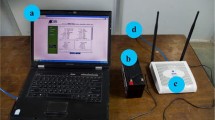Abstract
WiMAX technology carries the promise of broadband access and wireless coverage. Developing countries throughout the world have been fast at adopting and employing the new technology to bridge the digital divide. The deployment of WiMAX networks enables the validation and testing of the technology. It is imperative that the technology be tested in different environments and the results shared and compared. Jordan provides a unique environment in its architecture, building construction materials, usage model, topology and vegetation. This work considers a mobile WiMAX network operating at 3.5 GHz deployed in Amman, Jordan. The work presents a new model for predicting path loss based on the results of field measurements of signals power and it compares proposed model and measured data to different propagation models.
Similar content being viewed by others
References
IEEE Standard 802.16-2004 (2004). IEEE standard for local and metropolitan area networks. Part 16: Air Interface for Fixed Broadband Wireless Access Systems.
Grønsund, P., Grøndalen, O., Breivik, T., & Engelstad, P. (2007). Fixed WiMAX field trial measurements and the derivation of a path loss model, M-CSC.
Amarasinghe, K. C., Peiris, K. G. A. B., Thelisinghe, L. A. D. M. D., Warnakulasuriya, G. M., & Samarasinghe, A. T. L. K. (2009). Comparison of propagation models for Fixed WiMAX system based on IEEE 802.16-2004, ICIIS.
Alqudah, Y. A., & Tahat, A. (2011). Path loss and propagation models at 3.5 GHz using deployed WiMAX network. ICOIN.
Milanovic, J., et al. (2007). Comparison of propagation models accuracy for WiMAX on 3.5 GHz. In 14th IEEE international conference on electronics, circuits and systems, 2007 (ICECS).
Imperatore, P., Salvadori, E., & Chlamtac, I. (2007). Path loss measurements at 3.5 GHz: A trial test WiMAX based in rural environment. In Proceeding of the 3rd international conference on testbeds and research infrastructures for the development of networks and communities.
Moraes, E., et al. (2009). WiMAX near LOS measurements and comparison with propagation models. In 3rd European conference on antennas and propagation, 2009 (EuCAP 2009), 23–27 March 2009, pp. 1–4.
Sarkar T. K. et al (2003) A survey of various propagation models for mobile communications. IEEE Antennas and Propagation Magazine 45(3): 51–79
Chehri A., Fortier P., Tardif P. M. (2010) Characterization of the ultra-wideband channel in confined environments with diffracting rough surfaces. Wireless Personal Communications 62: 859–877
Ahmed, B., Masa Campos, J., Lalueza Mayordomo, J. (2011). Propagation path loss and materials insertion loss in indoor environment at WiMAX band of 3.3 to 3.6 GHz. Wireless Personal Communications, 1–10. doi:10.1007/s11277-011-0335-2.
Sebastião P., Velez F. J., Costa R., Robalo D., Rodrigues A. (2010) Planning and deployment of WiMAX networks. Wireless Personal Communications 55: 305–323
Torres R. P., Cobo B., Mavares D., Medina F., Loredo S. et al (2006) Measurement and statistical analysis of the temporal variations of a fixed wireless link at 3.5 GHz. Wireless Personal Communications 37(1–2): 41–59
Erceg, V., et al. (January 2001). Channel models for fixed wireless application, Tech. rep. IEEE 802.16 Broadband Wireless Access Working Group.
Okumura Y., Ohmori E., Kawano T., Fukuda K. (1968) Field strength and its variability in VHF and UHF land mobile radio services. Rev. Elec. Comm. Lab. 16: 825–873
Electronic Communication Committee (ECC) with the European Conference of Postal and Telecommunication Administration (CEPT), The analysis of the coexistence of FWA cell in the 3.3–3.8 GHz band, tech. rep., ECC Report 33, May 2003.
Hata M. (1980) Empirical formula for propagation loss in land mobile radio services. IEEE Transactions on Vehicular Technology VT-29: 317–325
COST Action 231 (1999). Digital mobile radio towards future generation systems, final report, tech rep., European Communities, EUR 18957.
Rimac-Drlje, S., et al. (2009). Receiving power level prediction for WiMAX systems on 3.5 GHz. WCNC.
Shahjahan, M., & Abdulla Hes-Shafi, A. Q. (2009). Analysis of propagation models for WiMAX at 3.5 GHz, M.S. thesis, Blekinge Institute of Technology, Karlskrona, Sweden.
Author information
Authors and Affiliations
Corresponding author
Rights and permissions
About this article
Cite this article
Alqudah, Y.A. Path Loss Modeling Based on Field Measurements Using Deployed 3.5 GHz WiMAX Network. Wireless Pers Commun 69, 793–803 (2013). https://doi.org/10.1007/s11277-012-0612-8
Published:
Issue Date:
DOI: https://doi.org/10.1007/s11277-012-0612-8




